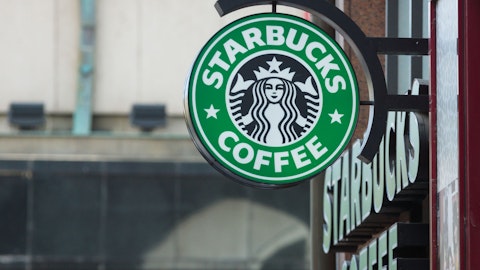Darden Restaurants, Inc. (NYSE:DRI) Q3 2023 Earnings Call Transcript March 23, 2023
Operator: Good day and welcome to the Darden Fiscal Year 2023 Third Quarter Earnings Call. Please note today’s conference is being recorded. If you have any objections, please disconnect at this time. I will now turn the call over to Mr. Kevin Kalicak. Thank you. You may begin.
Kevin Kalicak: Thanks, Todd. Good morning, everyone, and thank you for participating on today’s call. Joining me today are Rick Cardenas, Darden’s President and CEO; and Raj Vennam, CFO. As a reminder, comments made during this call will include forward-looking statements as defined in the Private Securities Litigation Reform Act of 1995. These statements are subject to the risks and uncertainties that could cause actual results to differ materially from our expectations and projections. Those risks are described in the Company’s press release, which was distributed this morning and in its filings with the Securities and Exchange Commission. We are simultaneously broadcasting a presentation during this call, which is posted in the Investor Relations section of our website at darden.com.
Today’s discussion and presentation include certain non-GAAP measurements, and reconciliations of these measurements are included in the presentation. Looking ahead, we plan to release fiscal 2023 fourth quarter earnings on Thursday, June 22nd, before the market opens followed by a conference call. During today’s call, any reference to pre-COVID when discussing third quarter performance is a comparison to the third quarter of fiscal 2020. Additionally, all references to industry results during today’s call refer to Black Box Intelligence’s, casual dining benchmark, excluding Darden, specifically Olive Garden, LongHorn Steakhouse, and Cheddar’s Scratch Kitchen. During our third fiscal quarter, industry same-restaurant sales increased 7.2% and industry same-restaurant guest counts decreased 3%.
This morning, Rick will share some brief remarks on the quarter and our focus moving forward, and Raj will provide more details on our financial results and an update to our fiscal 2023 financial outlook. Now, I’ll turn the call over to Rick.
Rick Cardenas: Thanks, Kevin. Good morning, everyone. We had a strong quarter on both the top and bottom line. We significantly exceeded the industry benchmarks for same-restaurant sales and traffic, outperforming more on traffic than we did on sales. We also continued to underprice inflation, resulting in lower overall check growth relative to the industry. Our ability to make this investment and provide strong value to our guests reinforces the power of our strategy, which comes to life through our four competitive advantages and executing our back-to-basics operating philosophy. I am particularly proud of the way our restaurant teams continue to execute at a high level by being brilliant with the basics. This intense focus on providing great food, service and atmosphere enables them to consistently create memorable guest experiences.
During the holiday season, Olive Garden and LongHorn Steakhouse set new all-time weekly sales records, only to break them during Valentine’s week. In fact, all of our brands achieved record total sales for the quarter. Of course, none of this would be possible without having the right people in the right roles ready to serve our guests. Our restaurants continue to be well staffed and our manager staffing remains at historic highs. Our leaders work hard to ensure each of our restaurants is a great place to work. During the quarter, several of our brands were recognized as industry leaders by Black Box Intelligence. LongHorn and Eddie V’s received the Best Practices Award, which evaluates the brand’s employee retention as well as sales and traffic performance.
Olive Garden, The Capital Grille and Seasons 52 were honored with the Employer of Choice Award, which is based on workforce data, including employee turnover and gender and racial diversity. We know from our recent engagement survey results that our overall level of engagement is very high, and our team members understand what is expected of them at work. This is helping drive high guest satisfaction metrics, both internally and externally. Data from the American Customer Satisfaction Index shows customer satisfaction is down across all industries. However, across all of our brands, our internal guest satisfaction ratings remain exceptionally strong. In fact, Cheddar’s Scratch Kitchen, Yard House and Bahama Breeze achieved all-time highs during the quarter.
Additionally, for the second consecutive quarter, the Darden brand was ranked number one among major casual dining brands in each measurement category within Technomic’s industry tracking tool. Even with the traffic growth we achieved during the quarter, to-go sales remained strong, accounting for 26% of total sales at Olive Garden, 14% at LongHorn and 12% at Cheddar’s. We continue to leverage technology to make it easier to order a pick up and pay without having to pass the added expense of third-party delivery on to our guests. Our teams are executing the off-premise experience at a high level. For example, to-go orders accounted for 33% of Olive Garden’s total sales on Valentine’s Day, and they significantly improved their ratings for both on-time and order accuracy for that day.
For the quarter, digital transactions accounted for more than 62% of all off-premise sales and 10% of Darden’s total sales. Finally, we opened 7 new restaurants during the quarter across 7 states. Our new restaurant opening teams continue to do an excellent job of hiring and training new team members and successfully opening these locations. We are on track to open 25 net new restaurants during the fourth quarter, and I am confident in our ability to do so because of our well-prepared leadership pipeline and the tremendous support teams we have in place. We are fortunate to have the best team members in the industry, and I am proud of the focus and commitment they continue to display. On behalf of our senior leadership team and the Board of Directors, I want to thank all of our team members for everything you do to nourish and delight our guests and each other.
Now, I will turn it over to Raj.
Raj Vennam: Thank you, Rick. Good morning, everyone. We had high expectations for the third quarter sales growth as we were wrapping on last January’s Omicron outbreak and several weeks of severe winter weather that combined to reduce sales by over $100 million in the third quarter of last year. Exceeded those high expectations, posting record total sales of $2.8 billion, which was 13.8% higher than last year, driven by 11.7% same-restaurant sales growth along with the addition of 35 net new restaurants. This same restaurant sales performance outpaced the industry by 450 basis points, and our same-restaurant guest counts performed even more as they exceeded the industry benchmark by 700 basis points. Diluted net earnings per share from continuing operations were $2.34, an increase of 21.2% above last year.
Total EBITDA was $448 million, and we returned $272 million of cash to our shareholders this quarter, consisting of $148 million in dividends and $124 million in share repurchases. Total pricing for the quarter was approximately 6.3%, 70 basis points below total inflation of roughly 7%. Now looking at our margin performance compared to last year. Food and beverage expenses rose 110 basis points, driven by commodities inflation of approximately 9%, which was higher than we anticipated going into the quarter and significantly outpaced pricing of 6.3%. Chicken, dairy and grains continue to be categories experiencing the highest levels of inflation, but each improved versus prior quarter as we expected. However, beef inflation increased from the second quarter level and drove the majority of our higher-than-anticipated commodities inflation this quarter.
Restaurant labor was 120 basis points better than last year as we benefited from sales leverage and our restaurants continue to run efficient labor despite hourly wage inflation of 8%. Total restaurant labor inflation was 7%. Restaurant expenses were 40 basis points favorable to last year as we leveraged higher sales that more than offset elevated inflation on utilities as well as higher repairs and maintenance expense. Marketing expenses were 10 basis points lower than last year, driven by sales leverage. G&A expenses were 40 basis points higher than last year, driven by the timing of our incentive compensation accrual and other expenses. Operating income margin of 12.6% was 30 basis points better than last year. Our effective tax rate for the quarter was 13.2%, and we ended the quarter with earnings from continuing operations of $287 million.
Now looking at our margin performance versus pre COVID, we grew operating income by 70 basis points, while underpricing inflation by more than 400 basis points since pre-COVID. Increased food and beverage costs were more than offset by improved productivity, reduced marketing and other cost savings initiatives. Looking at our segment performance. All of our segments significantly outperformed their respective industry benchmarks on both traffic and sales. Sales at Olive Garden grew 13.9% above last year, driven by same-restaurant sales growth of 12.3%. Average weekly sales at Olive Garden were 108% of pre-COVID level. Segment profit margin of 22.5% was 150 basis points better than last year, driven by sales leverage and labor efficiencies. LongHorn sales grew 13.5% above last year, with same-restaurant sales growth of 10.8%.
Average weekly sales at LongHorn were 127% of the pre-COVID level. Segment profit margin of 17.4% was 80 basis points below last year, driven by elevated commodities inflation. Sales in our Fine Dining segment grew 13.2% over last year driven by same-restaurant sales growth of 11.7% and average weekly sales were 113% of the pre-COVID level. Segment profit margin of 21.8% and was 110 basis points below last year, driven by elevated commodities inflation. Our other segment sales grew 14.1% above last year with the same restaurant sales growth of 11.7% and average weekly sales were 109% of the pre-COVID level. Segment profit margin of 14% was 20 basis points better than last year, driven by sales leverage and labor efficiencies. Turning to our financial outlook for fiscal 2023.
We have increased our guidance to reflect our year-to-date results and expectations for the fourth quarter. We now expect total sales of $10.45 billion to $10.5 billion, same-restaurant sales growth of 6.5% to 7%, approximately 55 new restaurant openings, capital spending between $550 million to $575 million, total inflation of 7% to 7.5% and annual pricing of 6% to 6.5%. Furthermore, we expect commodities inflation between 9.5% and 10%, the annual effective tax rate of approximately 13% and approximately 123 million diluted average shares outstanding for the year, all resulting in diluted net earnings per share between $7.85 and $8. This outlook implies fourth quarter sales between $2.73 billion and $2.78 billion, same-restaurant sales between 3% and 5%, diluted net earnings per share between $2.43 and $2.58.
It also implies higher commodities inflation than we last communicated. We now expect commodities inflation that is solidly in the low-single-digit range for the fourth quarter versus the closer to flat estimate we shared with you on the last earnings call. Increase in commodities inflation is primarily due to higher-than-anticipated beef costs. For fiscal 2024, we anticipate opening 50 to 55 new restaurants and capital spending between $300 million and $325 million related to new restaurants and another $200 million to $225 million related to ongoing restaurant maintenance, refresh and technology spending. And while we don’t normally provide a commodity outlook this early for the next fiscal year, we are anticipating low-single-digit inflation for the total commodities basket in fiscal 2024 led by high single-digit inflation on beef and produce.
We expect all other categories to range from slight deflation to low single-digit inflation. With that, I’d like to close by saying that we continue to be very proud of how our teams are managing their businesses to deliver strong results in this dynamic environment. Now, we’ll open it up for questions.
See also 12 Countries that Produce the Best Engineers and 20 Biggest Natural Resources Companies in the World.
Q&A Session
Follow Darden Restaurants Inc (NYSE:DRI)
Follow Darden Restaurants Inc (NYSE:DRI)
Receive real-time insider trading and news alerts
Operator: Our first question comes from Chris Carril with RBC Capital Markets.
Chris Carril: So, I just wanted to talk or ask first about the top line trends. So, I guess, just given the choppiness in the comparison to last year, could you talk about the progression of sales through the quarter? Maybe specifically what you saw following the Omicron lap, and maybe perhaps what you’re seeing in the current quarter just as we’re trying to get a sense of where trends are shaking out kind of on a normalized basis? I know, Rick, you spoke of the strength around the Valentine’s Day. So, any detail beyond that point would be great.
Raj Vennam: Hey Chris, this is Raj. Good morning. So, when we actually look at our underlying traffic trends versus pre-COVID, excluding the noise from holidays and weather and promotions, they’ve actually been fairly stable month-to-month and that has continued into the fourth quarter. And basically, everything we know of the quarter-to-date is incorporated in our guidance. But when you step back and look at versus pre-COVID, it’s pretty stable.
Chris Carril: And then, I appreciate the preliminary commodity inflation outlook for FY24. So, thanks for providing that this morning. Any thoughts on — or any guidance you could provide on how you’re thinking about just pricing here going forward just relative to that commodity inflation outlook that you’re providing for FY24?
Raj Vennam: Yes. Chris, I think the way we think about pricing is we look at total inflation. And I think as we talked about, over the last three years, we’ve underpriced inflation by over 400 basis points. And also, we’ve underpriced full-service CPI by over 600 basis points. So, we created a significant gap between our competitors, and it positions us well as we head into the next year. We’ll share more thoughts on our fiscal 2024 pricing plans the next — in the June call.
Operator: Our next question comes from Brian Harbour with Morgan Stanley.
Brian Harbour: Yes. Thank you. Maybe just a question on the labor side. I know that you’re in a very good place right now on staffing. Do you still see — as you look into next year, do you still envision taking up wages continually. And I think, obviously, we’re in an environment where it’s important to kind of retain people and continue to pay better than your peers. How does that kind of factor into what you expect from a wage inflation perspective going forward?
Rick Cardenas: Hey Brian, this is Rick. Let’s talk about our staffing. As we mentioned on our call, we’re very well staffed. We have more managers per restaurant than we’ve ever had in our history. So, we feel really good about where we are. We’re not going to talk necessarily about what our wage growth will be next year. I will say that even before COVID, wage inflation was in the mid-signal-digit. So, we will continue to work with whatever the economy comes our way and however we can handle that. But we have a great employment proposition. Our turnover is significantly reducing. It’s getting closer to our pre-COVID levels. And we still think we’ve got room to improve our turnover. We’re hiring great people and we’re being as discerning as we had been before COVID. So, we feel really good about where we are. And we’ll talk about our inflation targets and our pricing and all of those things in June.
Brian Harbour: Thank you. And maybe just on capital spending. I know you kind of took up the low end of that. But what’s driving that? Is there — is that more of an inflationary thing, or is there any sort of bucket of spending that’s running higher at this point?






